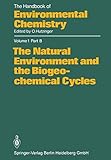The natural environment and the biogeochemical cycles Libro electrónico editors: O. Hutzinger, H.-J. Bolle, R. Fukai, J. W. de Leeuw, S. W. F. van der Ploeg, T. Rosswall, P. A. Schenck, R. Söderlund, Y. Yokoyama, A. J. B. Zehnder
Tipo de material: Libro
en línea Idioma: Inglés Series Detalles de publicación: New York, New York, United States Springer-Verlag c1982Descripción: xv, 320 páginas ilustraciones 25 centímetrosISBN:
Libro
en línea Idioma: Inglés Series Detalles de publicación: New York, New York, United States Springer-Verlag c1982Descripción: xv, 320 páginas ilustraciones 25 centímetrosISBN: - 9783662153246 (Print)
- 9783540385974 (Online)
- Disponible en línea
Incluye bibliografía e índice: páginas 305-317
1. Basic concepts of ecology.. 2. Natural radionuclides in the environment.. 3. The nitrogen cycles.. 4. The carbon cycle.. 5. Molecular organic geochemistry.. 6. Radiation and energy transport in the earth atmosphere system.. Subject Index
Disponible para usuarios de ECOSUR con su clave de acceso
Environmental Chemistry is a relatively young science. loteTest in this subject, however, is growing very rapidly and, although no agreement has been reached as yet about the exact content and limits of this interdisciplinary discipline, there appears to be increasing interest in seeing environmental topies which are based on chemistry embodied in this subject. One of the first objectives of Environmental Chemistry must be the study of the environment and of natural chemieal processes which occur in the environment. A major purpose of this series on Environmental Chemistry, therefore, is to present a reasonably uniform view of various aspects of the chemistry of the environment and chemical reactions occurring in the environment. The industrial activities of man have given a new dimension to Environmental Chemistry. We have now synthesized and described over five million chemical compounds and chemical industry produces about hundred and fifty million tons of synthetic chemicals annually. We ship billions of tons of oil per year and through mining operations and other geophysieal modifications, large quantities of inorganic and organic materials are released from their natural deposits. Cities and metropolitan areas of up to 15 million inhabitants produce targe quantities of waste in relatively small and confined areas. Much of the chemical products and waste products of modern society are released into the environment either during production, storage, transport, use or ultimate disposal. These released materials participate in natural cycles and reactions and frequently lead to interference and disturbance of natural systems. Inglés
Disponible en línea
Disponible en formato PDF


